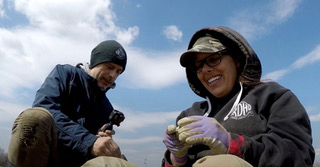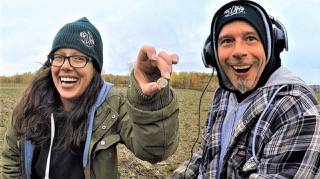  |
Minelab Detexperts, Laurie Gagne and Eric Danis, place family, fun, and helping others at the center of their hobby
Laurie Gagne was swinging her Minelab EQUINOX 800 metal detector in the Canadian province of Ontario in January of 2020. She was near the end of her hunt and was cold and tired. When the machine sounded off, she had no idea she would soon be holding one of the most significant finds of her detecting life.
She swung her machine again to pinpoint the target. It was just a small signal – barely a blip – and she had no idea what it might be. She asked a friend to check the signal with his Minelab CTX 3030 to see if it seemed worth digging. He agreed something was there. Luckily, the area had not completely frozen. Gagne and her friend were hunting an area where the St. Lawrence Seaway had recently receded, leaving only partially frozen ground. “We looked down and jammed up between some stones was the thin edge of a target standing straight on edge,” Gagne recalls. “That accounted for the relatively weak signal,” she explains. Carefully excavating the object, digging through the inch or so of partially frozen sand and rocks surrounding it, the item was finally brought to the light of day after being buried for centuries.
Gagne found herself holding a heavy object about the size of her hand. Brushing back the dirt revealed a brass plate with lettering around the edge and a design in the center. There was also a date along the bottom. The rare find was a military plate. The lettering read “Christiansted Burgher Company” and the date was 1765. Research on this plate revealed that Christiansted was the name of a town where a fort named Fort Christiansvaern previously stood. “Burgher” was the name given to a group of enlisted men, and “Company” means a body of soldiers. The fort had its own militia called the Christiansted Burgher Artillery. The plate was a find of a lifetime but would not be Gagne’s only significant find of the day.
Laurie’s detecting roots go back to her teenage years. Her first detector was an old one found in her father’s basement when she was 17 years old. It didn’t seem to work properly, and she had no owner’s manual nor internet to show her how to use it. Yet that old, fickle machine planted the seeds of detecting intrigue that would grow into a full-blown passion later in life.
In 2009, Laurie’s husband, Eric Danis, was working with a guy who showed him a bunch of neat stuff – and a lot of junk – he had found with his metal detector. Eric brought up the subject at dinner that night. The next morning, Laurie brought him a cup of coffee along with an online ad she had found for a used detector. They ended up meeting the seller in a parking lot where they purchased the machine out of the back of his car. They packed up their two young kids and drove to her grandfather’s late-1700’s farm. Soon after arriving, Laurie dug her first large cent, and the whole family was hooked on the hobby.
Not long after, they sold the first machine and bought a newer model, which the entire family shared for about seven years. “Sharing a detector and taking turns suited us perfectly,” Laurie says. “Our children were only one and three years old, so one of us would entertain the kids while the other would swing the detector. Whenever we found something we would all mash our heads together to look inside the hole.” Laurie and Eric feel lucky to be able to share such an incredible hobby together, and with their children. “Our kids are now teens and they still love our outdoor adventures.”
Laurie and Eric searched for the right detector for many years. Their other detectorist friends all used Minelab machines, and they couldn’t ignore the success they were having with them. When the EQUINOX 800 came out, it had everything Laurie and Eric wanted. It was wireless, waterproof, and uniquely suited for multiple types of detecting with Minelab Multi-IQ technology. It seemed perfect, and when they actually saw what the 800 could do in the field, they hung up their old detectors and began to enjoy detecting at an all-new level. They took their EQUINOX 800s to previously hunted spots and made a world of new discoveries. Minelab took note of the couple’s work, and recognized Laurie and Eric as Minelab Detexperts, a global team of detecting experts who serve as helpful ambassadors for the both the Minelab brand and the hobby as a whole.
Laurie and Eric hunt for everything: coins, relics, jewelry, and even recently lost items like rings and cell phones, which they joyfully attempt to return to their grateful owners. But living in Quebec, they are forced to dig by the seasons. Once it gets cold and the ground freezes they can only hunt under special circumstances. Winter is largely spent researching. Spring is when they detect farm fields and other areas that become too overgrown to search in the summertime. By the end of May, the fields are planted and summer detecting starts. They primarily hunt private property, forests, parks, and beaches. Fall hunting starts when the fields open back up. Laurie and Eric also travel to detect other carefully researched sites farther from home. “We’ve hunted silver and gold mining towns, ghost towns, and drowned villages from Quebec to British Columbia,” Laurie says. “We love to travel and explore amazing places with friends.”
The couple has a system for requesting permission to hunt on private property. “When we go to the door, we smile and say hello and quickly add we are metal detectorists,” Laurie says. “If they smile, we pause and allow them to say something. If they look at us in an odd manner, we add that we were researching their area or were simply just driving by and noticed their beautiful old house. Then we tell them our intentions.”
Working as a team, Laurie and Eric have found hundreds of coins dating from 1723 to the present. Eric found a 1600’s French Biscayne trade axe, and a Victorian gold snake ring which Laurie wears every day. One of Eric’s favorite finds was a spill of Native American fur trade silver. It included six silver ear bobs, two silver trade rings, and a trade brooch. He also found a copper culture two-tanged crescent knife that dates to approximately 4000 BC. He is currently working with an archeologist to decide the best place to donate this incredible item.
Laurie’s other outstanding find, discovered the same day as the Burgher Company Brass Plate mentioned earlier, is an extremely rare coin called the Vexator Canadiensis, which means Tormentor of Canada in Latin and is believed to have been made in Quebec in the 1830’s. This copper coin was made to mock the unpopular King William the 4th as a tormentor of Canada. Cleverly, the “X” in Vexator was made to resemble an “N”. Venator Canadiensis means “Trapper” of Canada to avoid prosecution by the British government.
INSERT COIN IMAGE
When asked about their future plans in the hobby, Laurie explains: “Eric and I have been helping others improve their knowledge and skills because we really enjoy teaching about detecting. When I received my EQUINOX, I studied the manual and created a tutorial series on YouTube. We love answering questions and assisting people in learning about their Minelab machine and using its capabilities to the fullest. We hope to continue doing this, and of course, searching the grounds of Canada for more pieces of lost history.”
When not detecting, Laurie and Eric enjoy wild canoe camping, fishing, playing musical instruments, and oil painting on canvas.
Keep up with Laurie and Eric on Facebook and YouTube.
Story by Rich Creason.
